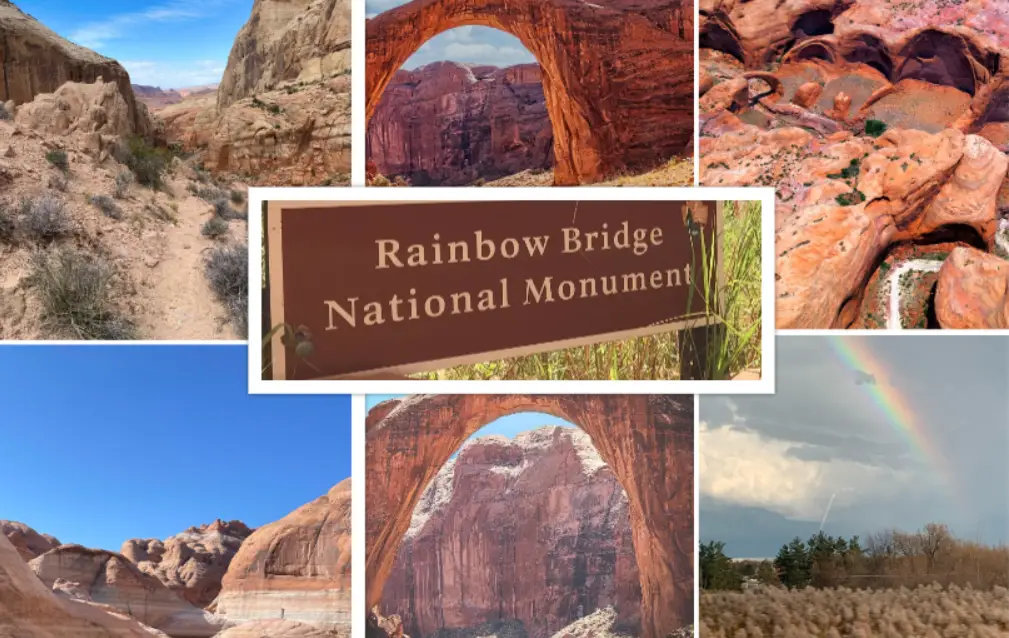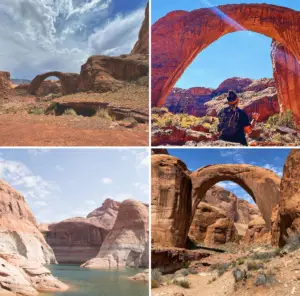Rainbow Bridge National Monument : Interesting Facts, History & Travel Guide

- By
- Aparna Patel
- |
- 13 Apr, 2023
- |

Welcome to our blog post on the Rainbow Bridge National Monument! This breathtaking natural wonder is located in southern Utah, USA and attracts visitors from all over the world. The Rainbow Bridge is not only a stunning sight to behold, but it also has a rich history and cultural significance for the Native American tribes that have lived in the area for centuries.
In this post, we will take a closer look at the history of Rainbow Bridge, its geological features, and share some interesting facts about this magnificent monument. We will also provide a travel guide for those planning to visit, including tips on how to get there, when to go, and what to expect during your trip.
Whether you’re a nature lover, a history buff, or simply looking for a unique travel experience, the Rainbow Bridge National Monument is definitely worth adding to your bucket list. So, let’s dive in and discover all that this incredible destination has to offer!
Table of Contents
Interesting facts about Rainbow Bridge National Monument
- Rainbow Bridge National Monument is located in southern Utah, in the United States. It is situated in the Glen Canyon National Recreation Area and is accessible by boat or hiking.
- Rainbow Bridge is one of the world’s largest natural bridges, with a span of 275 feet and a height of 290 feet. It is considered sacred by several Native American tribes, who have used the site for spiritual ceremonies for centuries.
- The bridge was discovered in 1909 by two white explorers, who named it “Rainbow Bridge” because of its colorful rock formation.
- The area surrounding Rainbow Bridge is home to a variety of wildlife, including bighorn sheep, mountain lions, and golden eagles.
- Rainbow Bridge is made of Navajo sandstone, which was formed during the Jurassic period. The sandstone is believed to be over 200 million years old.
- The National Park Service manages Rainbow Bridge National Monument, which was designated a national monument by President William Howard Taft in 1910.
- Visitors to Rainbow Bridge can access the site by boat on Lake Powell, which is part of the Glen Canyon National Recreation Area. There is also a hiking trail that leads to the bridge, but it is a strenuous 14-mile round-trip trek.
- In addition to Rainbow Bridge, the area surrounding the bridge is home to a number of other natural wonders, including slot canyons, red rock formations, and the crystal-clear waters of Lake Powell.
- The Rainbow Bridge Trail is closed to visitors during the winter months due to the risk of flash floods and icy conditions.
- Rainbow Bridge is a popular destination for photography and has been featured in numerous films and TV shows, including the 1963 film “The Greatest Story Ever Told” and the TV series “Breaking Bad.”
Read More:
- President Lincoln and Soldiers’ Home : Interesting Facts, History
- Prehistoric Trackways National Monument : Interesting Facts, History & Travel Guide
- Pompeys Pillar National Monument : Interesting Facts, History & Travel Guide
- Pipe Spring National Monument : Interesting Facts, History & Travel Guide
- Petroglyph National Monument : Interesting Facts, History & Travel Guide
- Organ Pipe Cactus National Monument : Interesting Facts, History & Travel Guide
Can you drive to Rainbow Bridge National Monument
No, Rainbow Bridge National Monument is only accessible by boat or by hiking. The nearest road access is at the Navajo Mountain Trading Post, which is about 2 hours away by car from the monument. From there, visitors can arrange for a guided tour or rent a boat to travel to Rainbow Bridge via Lake Powell. There are also hiking trails that lead to Rainbow Bridge, but they are quite strenuous and should only be attempted by experienced hikers.
How was Rainbow Bridge formed?
Rainbow Bridge is a natural sandstone arch that was formed by erosion. It is located in southern Utah, in the United States. The bridge was created over a long period of time, as the rushing waters of the nearby Navajo Creek eroded away the softer sandstone layers, leaving behind the harder, more durable layers that eventually formed the bridge.
Scientists believe that the formation of Rainbow Bridge began about 200 million years ago, during the Triassic period. At that time, the area was covered by a shallow sea, and sediment began to accumulate on the sea floor. Over time, the sediment was compressed and hardened into sandstone. About 70 million years ago, the region was uplifted and the land began to rise, exposing the sandstone layers to the elements.
As rain and snowmelt flowed through the sandstone, it eroded away the softer layers, leaving behind the harder, more resistant layers that eventually formed the bridge. The arch continues to be shaped by erosion today, as wind and water slowly wear away at the sandstone.
Information & History of Rainbow Bridge National Monument
Rainbow Bridge National Monument is a natural bridge located in southern Utah, in the United States. It is situated in the Glen Canyon National Recreation Area and is accessible by boat or hiking. Here’s a brief history and information about the monument:
Discovery and Naming:
Rainbow Bridge was discovered in 1909 by two white explorers, who named it “Rainbow Bridge” because of its colorful rock formation. It was also known as “the world’s highest natural bridge” until 2006 when a bridge in China surpassed it.
Native American Significance:
Rainbow Bridge is considered sacred by several Native American tribes, including the Navajo, Hopi, Paiute, and Zuni. These tribes have used the site for spiritual ceremonies for centuries. The Navajo call the bridge “Nonnezoshe,” which means “rainbow turned to stone.”
Geology and Formation:
Rainbow Bridge is made of Navajo sandstone, which was formed during the Jurassic period. The sandstone is believed to be over 200 million years old. The bridge was formed by erosion, as water from the nearby Navajo Mountain slowly wore away the rock over millions of years.
Designation as a National Monument:
Rainbow Bridge National Monument was designated a national monument by President William Howard Taft in 1910. It is managed by the National Park Service, which maintains the area and provides guided tours and educational programs for visitors.
Access to the Monument:
Visitors to Rainbow Bridge can access the site by boat on Lake Powell, which is part of the Glen Canyon National Recreation Area. There is also a hiking trail that leads to the bridge, but it is a strenuous 14-mile round-trip trek. Due to the risk of flash floods and icy conditions, the Rainbow Bridge Trail is closed to visitors during the winter months.
Conservation Efforts:
In recent years, there has been concern about the impact of tourism on Rainbow Bridge National Monument. The National Park Service has implemented measures to reduce the impact of visitors, including limiting the number of boats that can dock near the bridge at any given time.
Rainbow Bridge is a stunning natural wonder and an important cultural and spiritual site for several Native American tribes. It is a must-see destination for anyone visiting the southwestern United States.
Travel Guide for Rainbow Bridge National Monument
Rainbow Bridge National Monument is a natural wonder located in southern Utah, in the United States. Here’s a travel guide for visiting the monument:
Getting There:
The monument is located in the Glen Canyon National Recreation Area and is accessible by boat or hiking. The most popular way to get there is by boat on Lake Powell. Visitors can rent a boat or take a tour from one of the marinas in the area, such as Wahweap Marina or Antelope Point Marina. The monument can also be accessed by hiking the Rainbow Bridge Trail, which is a strenuous 14-mile round-trip trek. The trailhead is located at the Rainbow Bridge National Monument parking lot, which is accessible from US Route 89.
When to Go:
The best time to visit Rainbow Bridge National Monument is between April and October when the weather is mild and the lake is calm. The monument is open year-round, but the Rainbow Bridge Trail is closed to visitors during the winter months due to the risk of flash floods and icy conditions.
What to See and Do:
The main attraction at Rainbow Bridge National Monument is, of course, the bridge itself. Visitors can take a boat tour or hike the Rainbow Bridge Trail to see the bridge up close. Along the way, visitors will also see stunning views of the surrounding red rock formations and the crystal-clear waters of Lake Powell.
There are also several other activities to do in the area, including kayaking, fishing, and exploring the nearby slot canyons. Visitors can also take a guided tour of the Glen Canyon Dam, which is located nearby.
Where to Stay:
There are several accommodation options in the area, including hotels, motels, and campgrounds. The town of Page, Arizona, which is located near the monument, has a variety of lodging options. There are also several campgrounds in the area, including Wahweap Campground and Lone Rock Beach Campground.
Tips for Visiting:
- Be sure to bring plenty of water and sunscreen, as the area can get very hot in the summer months.
- Wear comfortable shoes for hiking the Rainbow Bridge Trail.
- Follow Leave No Trace principles to minimize your impact on the environment.
- Respect the cultural and spiritual significance of Rainbow Bridge to the Native American tribes in the area.
- Check the National Park Service website for updates on trail conditions and other important information before visiting.
FAQ about Rainbow Bridge National Monument
How was Rainbow Bridge formed?
Rainbow Bridge was formed by erosion, as water from the nearby Navajo Mountain slowly wore away the rock over millions of years.
How can I visit Rainbow Bridge National Monument?
The monument is accessible by boat on Lake Powell or by hiking the Rainbow Bridge Trail. Visitors can rent a boat or take a tour from one of the marinas in the area or hike the trail from the Rainbow Bridge National Monument parking lot.
Are there any restrictions for visiting Rainbow Bridge National Monument?
Yes, visitors are not allowed to climb on or touch the bridge, and boats are not allowed to dock within 200 feet of the bridge. There are also restrictions on camping and campfires in the area.
When is the best time to visit Rainbow Bridge National Monument?
The best time to visit Rainbow Bridge National Monument is between April and October when the weather is mild and the lake is calm. The Rainbow Bridge Trail is closed to visitors during the winter months due to the risk of flash floods and icy conditions.
Is Rainbow Bridge National Monument wheelchair accessible?
The Rainbow Bridge Trail is not wheelchair accessible. However, visitors with disabilities can take a boat tour to see the bridge.
Are pets allowed in Rainbow Bridge National Monument?
Pets are not allowed on the Rainbow Bridge Trail or on boat tours to the bridge. However, pets are allowed in designated areas of the Glen Canyon National Recreation Area.
More Post
Search Posts
Latest posts
-
4 Mar, 2024
Why would you wrap your luggage in plastic?
Popular posts
-
5 Mar, 2024
Why prohibit engine braking?
